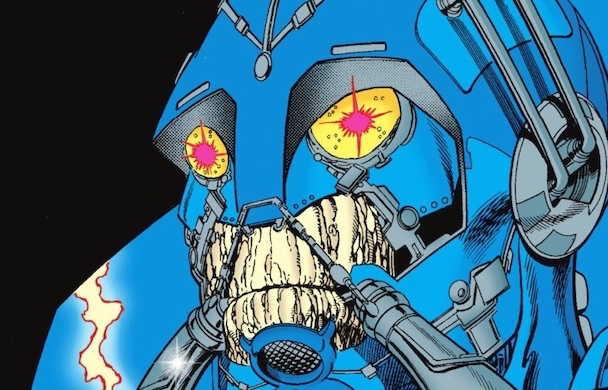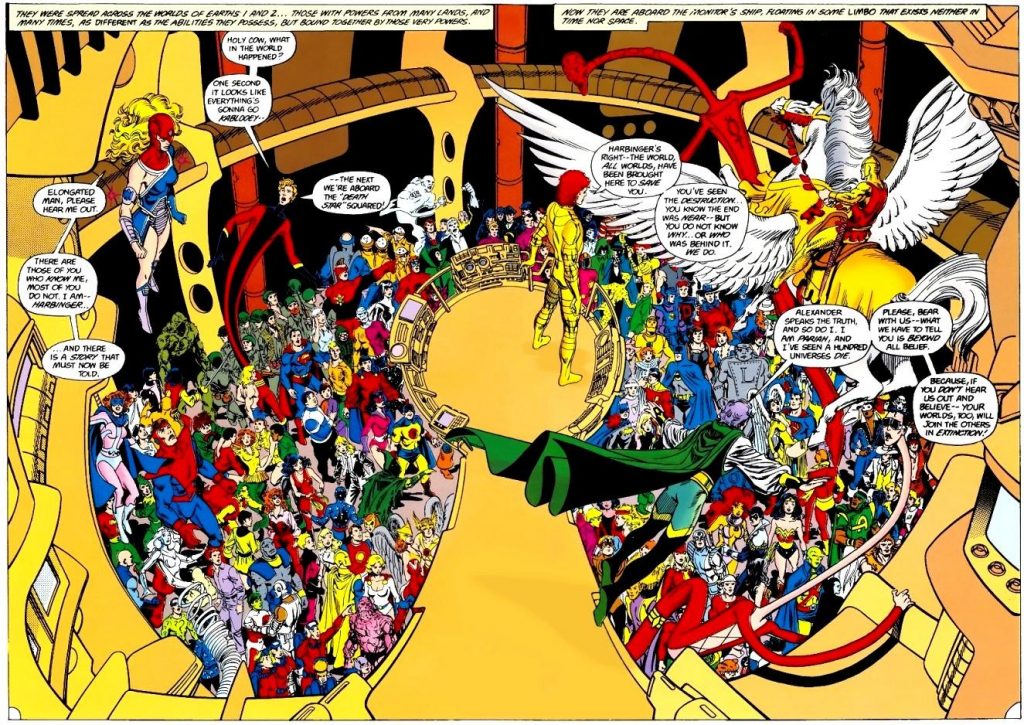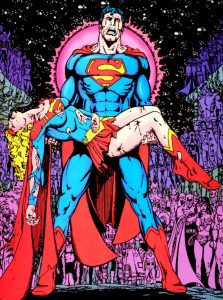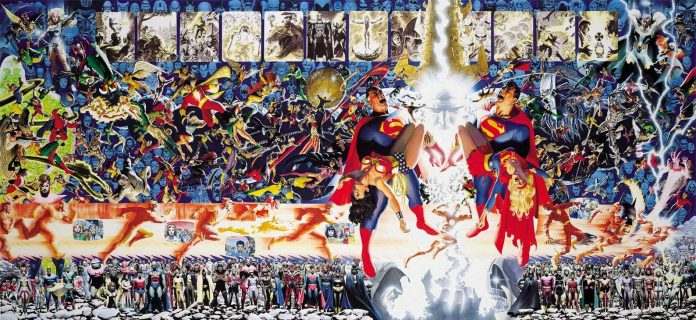
Long has the feud transpired between 2 behemoths in the comic book industry: DC and Marvel. With both companies having major event storylines in comics, the ones that stand out for each are two cataclysmic events which forever altered their respective universes: DC’s Crisis on Infinite Earths (1985) and Marvel’s The Infinity Gauntlet (1991), which is part inspiration for the Infinity War film premiering in May 2018.
Both titles feature art by one of my all-time favorite artists, the renowned George Perez, but DC Comics’ Crisis was penned by Marv Wolfman while Marvel’s Infinity was written by Jim Starlin – both industry legends. While more may prefer Marvel’s tone to DC’s, or find the material more approachable, to me, there is no contest when it comes to choosing the better book. Here are the five reasons why Crisis on Infinite Earths is so much better than The Infinity Gauntlet! WARNING: THIS ARTICLE DOES DISCLOSE SPOILERS!
5) Crisis Is More Epic in Scale

Written about four years before Infinity Gauntlet’s six-issue run, Crisis lasted 12 issues and featured more characters, scenes, plots, and tragedy. Most of Gauntlet’s action took place out in the farthest reaches of vast space, whereas Crisis took place not just in space, but throughout the many earths which populate the entire, expanded DC universe. Even though Perez penciled both works, his scenery in Crisis was much more detailed compared to Gauntlet. This gives Crisis an edge over Gauntlet, engrossing the reader in worlds which feel real and exciting, making the story all the more memorable.
4) DC’s Baddie Anti-Monitor Is a More Formidable Threat than Thanos

Gauntlet begins with a threat to everyone and everything. Thanks to Death, Thanos – the Mad Titan – comes into possession of the Infinity Gauntlet after acquiring each of the Infinity Gems (read The Thanos Quest), and each gem represents a major, powerful element: soul, time, space, mind, reality, and power. Basically, this gauntlet makes Thanos indestructible to anyone and everyone.
However, rather than completely destroy everyone and take over all he can imagine, Thanos does hardly anything with the weapon. The worst he does is make half the universe’s population disappear. There are a few notable death scenes related to famous Marvel characters, but they are not very impressionable, and Thanos spends most of his time pining and whining over the fact that Death doesn’t love him; basically, it’s a love story gone wrong.
And Thanos is the biggest joke of all; it was explained that every time he claimed victory in the past, he gave up what was won. This makes him a less-than-formidable foe who pales in comparison to DC’s threat prevalent in Crisis.

DC’s Anti-Monitor, on the other hand, thinks bigger and does not let emotion get in the way. Anti-Monitor wants to destroy many of the other earths and replace them with his own versions, killing billions of sentient beings in the process. There is no pining over unrequited love or remorse, but merely a relentless drive for power.
SPOILER ALERT: The best testament to each villain’s threat is how the story ends: The Anti-Monitor must be defeated and destroyed by three major heroes with the help of Darkseid. Thanos, on the other hand, is talked into surrendering and ends up retiring on some unnamed planet which vaguely resembles farmland in Kansas. WHAT???
3) DC’s Character Roster Is More Useful

Each book sees a lot of noticeable characters making an appearance. However, Marvel prevented their involvement of too many characters by having half of the universe’s population disappear, taking some of the heroes with it. So, only a few of the popular Marvel characters (Captain America, Iron Man, Hulk, Thor, Dr. Strange, Silver Surfer, Dr. Doom, Wolverine, Spider-Man, Cyclops, Scarlet Witch) make an appearance in the book.
And those characters (save Surfer and Dr. Strange) don’t make lengthy appearances as the story focuses on characters who’ve not stood the test of time, or who are all but non-existent these days (i.e., Adam Warlock, Death, the Stranger, Kronos, Eternity, Epoch, Love and Hate, Eros/Starfox, and Pip the Troll).
DC’s story has every major character (i.e., Superman, Batman, Flash, Firestorm, Green Lantern, Supergirl, Shazam, Blue Beetle, etc.), as well as their Earth-2 counterparts, and some characters from the Golden and Silver Age of comics (i.e., Uncle Sam, Sgt. Rock, The Losers, Shining Knight, etc.) taking a major role in the overall story. Even the (in)famous villains of the DC universe have an entire issue devoted to their involvement.
Most of Marvel’s characters are only viewed on a computer screen, and even the ones who do make major appearances, like Spider-Man, don’t really make an impact on the story or action. In Crisis, whether they are major or minor, most characters make a significant difference in the plot. Each hero in Crisis uses their strengths to do what is best for the advancement of saving the infinite earths; Marvel’s heroes are merely used as cannon fodder – as admitted by protagonist Adam Warlock.
2) DC’s Loss Is More Significant

Unlike Crisis, Marvel’s story ends with a moderately infuriating narrative that has carried over into its movies: there are no true losses. All of the famous heroes who were killed and/or disappeared throughout the story were magically brought back to life.
DC’s deaths are not only shocking but they lasted for 23 years in comics! And when the famous heroes did return, their absence became major storylines which caused ripples that still reach to the latest major event, “Rebirth.”
The end panels showing the conclusion to each major character in each work are what best prove my point: Marvel’s characters don’t really remember anything or why they feel different as they go about their everyday lives; DC’s heroes are seen mourning, honoring the fallen heroes’ sacrifices; they know their lives will never be the same. This conveys to the reader that, like in the real world, there are emotional moments that can’t be magically reset, making Crisis far more memorable.
While Marvel and DC both had sequels to their respective works, only DC’s had a considerable impact on its storytelling and characters’ lives.
1) Marvel’s Premise Falls Flat; DC Created a True Legacy

- The problem Marvel had with its seemingly fantastic, action-packed plot was that writer Jim Starlin – as much as I like and respect him – wrote himself into a corner. Specifically, he gave one of Marvel’s most notorious (but not at all the most evil) villains the most powerful item ever created in comics. There was no way any character in the Marvel universe could defeat a character with an item that could alter time, reshape matter, control emotions, control souls, and access all the power that ever existed.
- To bring in cosmic entities to defeat Thanos was the only way to go – even ones many were unfamiliar with during the time of its original release. This led to a bunch of big, colorful explosions and pretentious dialogue where nothing really important was said.
- And, after six issues of invested time and money, the end didn’t have some brilliant, philosophical meaning which I’m sure Starlin was going for; rather, it came off as a waste of time full of silliness and quick, cartoon-like deaths for readers who were actually expecting some kind of emotional story. “Crisis,” on the other hand, had meaningful loss, edge-of-your-seat storylines, masterful pacing, and left a philosophical impression Marvel had tried so hard to achieve, but failed.
Those are my reasons, but I’m sure there are reasons I’m missing. Or, maybe you completely disagree with me and think Infinity Gauntlet is far more superior. If so, let me know in the comments section below!


